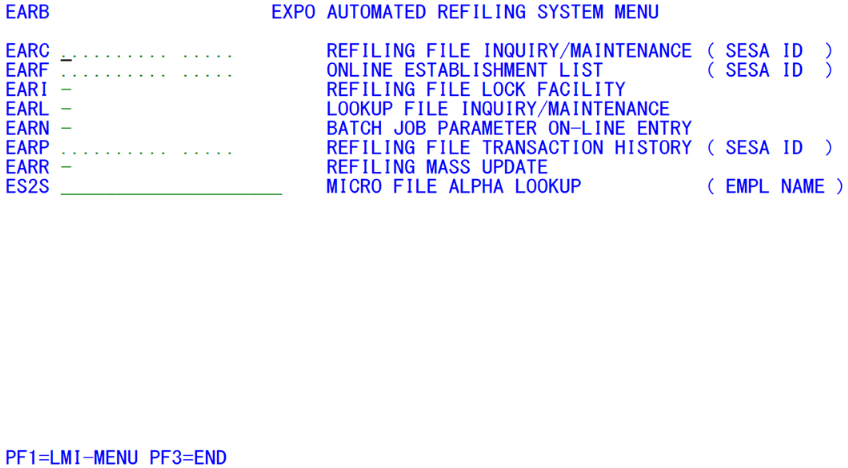05 earb ears menu
EARB - EARS Menu
| Program ID: | EARBP01 |
|---|---|
| Mapset: | EARBMS1 |
| Files: | (none) |
This is the menu screen that ties the Exportable Automated Refiling System (EARS) together. Each transaction needed for processing is listed and may be selected by cursor position. The employer account number is included wherever it is applicable, so that a specified account can be displayed immediately upon transfer to the requested CICS transaction. In this same vein, an alpha locator key can be specified for the ES2S transaction. Every system CICS transaction may return to the menu screen via the F1 key.
The use of the F1 key in the EARB screen will return control to ES2A for transfer back to the ES2B EXPO menu. The F3 key, when entered here or in any other system screen, will exit the EARS/EXPO system by way of the ES2KP01 program (described earlier in this section). Each of the transactions listed above will be described individually in the pages that follow.
Note that not all of the menu items here are truly EARS-specific. The ES2S alpha-locator transaction is called directly from EARB, since there is no EARS equivalent, though there is still a need to search for accounts by name or EIN. The other transactions parallel EXPO processes, but are applied to EARS. EARC is an on-line Refiling File maintenance process, equivalent to ES2C with the Micro File. EARF is a general establishment list utility that is similar to ES2F. EARI is a Refiling File lock utility, roughly equivalent to the ES2I micro data locking function. EARL’s Lookup File maintenance is a subset of ES2L. EARN is an EARS batch job parameter entry function modeled after ES2N characteristics. EARP shows Refiling transaction records just like (but more simply than) ES2P’s micro-related transactions. The mass data entry of EARR is not directly equivalent to ES2R’s MWR processing function, since EARR is not limited to dealing strictly with multi-worksite families; otherwise, though, it is a similar volume-entry design.
Related Links
